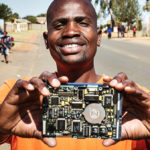Considering the significant role that technology and the internet plays for many individuals, it may be a surprise that there are still over three billion individuals worldwide without reliable access to technology or the internet. Research has shown that access to the internet leads to more learning opportunities. According to UNESCO, having digital skills is crucial for future participation within the global economy.
I am the manager of the education investment portfolio for Cisco and the Cisco Foundation. And yet, my colleagues may not be aware of how access to technology changed my life. My educational journey was influenced early on by technology. It continues to influence the work I enthusiastically do today – empowering nonprofits to use technology to improve education for students everywhere.
Teachers had a significant influence on my life

My first interaction with computers was in elementary school. My interest in technology started at an early age because my sixth-grade teacher introduced me to it in the classroom. While my peers were outside playing in the schoolyard, I was with a group of kids, huddled around a Commodore PET computer (one of the first commercially available personal computers) in the corner of our classroom.
I was grateful that my school made technology accessible. I grew up in a home without the means to have a computer. I come from a background with a parent who was disabled, and at times my family struggled to get by without help from our local community. Despite these challenges, my parents encouraged me to view education as a pathway to opportunity and engage with the world around me. They taught me that my teachers could be partners in exploring the world.
Having teachers who introduced me to technology and fostered interests in math, science, and engineering changed my life. Their efforts inspired and guided me to study engineering and business, leading teams of engineers to build large-scale distributed computing systems on the internet. Without the role of teachers encouraging and guiding my educational journey, I wouldn’t be where I am today.
Today’s education is tied to internet connectivity
When accessing education, global barriers can be significant. There may be language and cultural barriers when students access content, or locations where students lack access to qualified teachers. In other cases, students deserve a safe learning environment that’s free from conflict – whether social, economic, or political. Geography, weather, and climate all contribute to conditions that determine if students can attend school. And as the pandemic of 2020 has proven, it’s difficult to access education without adequate and reliable internet connectivity.
But the barriers to accessing education are different around the world. In the United States, we have large populations of students with limited or no access to the internet. Many US homes don’t have any digital devices at all. And looking at other parts of the world, in Africa or Latin America, many communities have no access to the internet. And even then, access to a device may be rare or intermittent.
There is a clear need for education to be delivered over the internet, which can bridge barriers to education globally. According to UNESCO, half of all learners kept out of the classroom due to the pandemic do not have access to a household computer (836 million students), and 43 percent (or 706 million students) have no internet at home.
Delivering learning and digital skills development through our partners
Globally, barriers to educational access can cause diverse gaps in education attainment by students. Addressing these gaps presents a challenge for all of us to innovate around new solutions that can adapt to changing conditions, remain open and accessible, directly support teachers, and elevate teachers’ proven practices globally. Cisco can’t meet this need alone. To overcome these significant barriers to accessing education, we need to continue to build innovative and mission-driven partnerships that involve governments, nonprofits, and other community stakeholders worldwide.
Cisco’s current scope of EdTech partners excel at internet access through adaptive solutions. Like TalkingPoints, which uses commonly available mobile phone and text message capabilities to enable teachers to communicate with students’ families in their home language.
We also have partners like CommonLit, which provides culturally relevant reading lessons for students from varying racial or ethnic backgrounds, fostering greater engagement, critical thinking, and literacy.
MIND Research Institute offers an award-winning visual instruction program, called ST Math, which helps elementary and middle school students improve their math performance. With visual learning, there are no language barriers, so the program is accessible to all students.
We also support educators through New Teacher Center, which builds student-teacher trust by reducing bias and helps teachers build strong and empathic relationships that provide students with essential needs for whole child development.
Without Cisco’s partners in the public, private, and nonprofit sectors, we would be unable to inclusively address the global barriers that exist for students, their teachers, and accessing education throughout the world. Cisco will continue to work with partners and educators worldwide to find innovative uses of technology and the internet that adapt to these diverse conditions, bridge these gaps, and improve access to education globally.
Are you interested in learning more about Cisco’s social investments in learning and digital skills development? Please visit our Learning and Digital Skills Development page to discover more about how we are creating new opportunities for individuals to thrive.


Great article Kyle! Love seeing your school-age photo!
Great read, Kyle! Very cool of you to share of your own journey in a way that illuminates your passion for the work you do. Great teachers and engaging tech changed my life as well. 🙂
Kyle, great article! Was nodding my head in agreement throughout. We obviously share a common passion in education and access to technology. I’m the CEO and founder of Workshops for Warriors ( wfw.org ) where we provide transitioning service members and veterans compressed training, certification, and job placement assistance in the advanced manufacturing sector. During the COVID pandemic we have been able to continue our operations through virtual learning, in large part due to Cisco technology. Thanks for what you do and thanks to Cisco for supporting our Nation’s veterans.
Actively monitor student use of the technology. Walk around the classroom, looking over students’ shoulders to check such things as windows that have been minimized at the bottom of a computer screen. It’s good to trust your students, but they need to know that you expect them to be focused on learning.
I agree! The walls of the classrooms are no longer a barrier as technology enables new ways of learning, communicating, and working collaboratively.